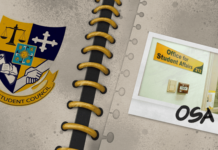In its eager rush to produce 400 books in time for the 400th anniversary of UST in 2011, is the UST Publishing House (USTPH) sacrificing quality for quantity?
No, said USTPH director Mecheline Manalastas. The books are for the benefit of the public and not just to complete the target, she explained. But it is presumptuous to assume all books are of the same high quality, she added.
Although the USTPH has just been named again publisher of the year in the National Book Awards, the award, critics said, seemed more a pat in the back of UST for running against the university publishing tide rather than an accolade for the consistent quality of its books.
USTPH is publishing 40 titles and even more every year. That’s one book per 1.3 weeks, a feat in Philippine publishing.
To date, 190 books in various fields have been published. Thirty books were launched last Sept. 8 while 10 more will be launched in December.
The feat of USTPH could be appreciated when one considers previous recipients of the publisher of the year award have slowed down. Anvil Publishing hardly publishes literary titles because they are losing ventures. The University of the Philippines Press still publishes new books, but not as frequently as USTPH’s. Bookmark has stopped publishing.
And De la Salle University Press, which has not yet won publisher of the year, has faltered considerably in the last years so that even DLSU faculty members are submitting manuscripts to the USTPH.
Juaniyo Arcellana, a member of the Manila Critics Circle (MCC) which gives out the National Book Awards, has high praises for the USTPH.
“The books (published) by the USTPH have been consistently good, not only the volume, but the quality as well,” Arcellana told the Varsitarian in a phone interview.
MCC chair and UST Center for Creative Writing and Studies director Ophelia Dimalanta agreed.
“The books this year are of good quality. The packaging and design are remarkable; even the judges (of the book awards) were impressed,” she told the Varsitarian.
Perhaps USTPH’s advantage is that it has the support of the UST administration, Manalastas said. The UST press is a non-stock, non-profit organization and depends on the UST administration for its budget.
“We have good production because our budget is not limited,” Manalastas said. “But I also try to take advantage of (grants and donations).”
Dimalanta said administrative support separates the USTPH from other university publishers.
“The USTPH is the most active publisher (among schools). Universities like UP, La Salle, and Ateneo reject manuscripts because of economic reasons,” Dimalanta said.
According to Manalastas, the project to produce 400 titles in time for the University’s quadricentennial gives priority to Thomasian authors, writers and editors. The project seeks to promote UST as a source of intelligent publications by talented and erudite authors, writers, editors and researchers.
Going by the numbers, USTPH has improved its batting average, winning six of 11 categories in the book awards were its titles were nominated. Because of the wins, as well as for having produced an extensive catalogue that covered varied fields such as history, literature, philosophy, theology and the sciences, it got the top award, publisher of the year.
Manalastas said USTPH’s best-selling books are mainly in the creative arts, but it is slowly being recognized for its history works as well. This could be gleaned from its two top best sellers: Frank Rivera’s “Oyayi,” a collection of dramas, and the Filipino translation of Carmen Guerrero-Nakpil’s collection of historical essays, “Mga Kuwento sa Kasaysayan.”
Major bookstores like National Bookstore and Powerbooks have stocked up on USTPH titles. Libraries have been placing orders.
USTPH prices are considered affordable – ranging from P100 to P1,000. Most of its titles sell below P400.
However, publishing a great amount of books has problems, such as marketing and editing.
Manalastas said the books did not sell when the project started in 2001. But today, various marketing strategies seek to ensure a wider reading public for them.
“We talk to the authors to assist us in marketing by having their own launching as well,” Manalastas said.
“Some authors, especially Thomasians, feel that their manuscripts are already good. The question is whether they are marketable (or not.)”
Some titles have a specialized public.
“Liyab,” by well-known poet Roberto Añonuevo, is described by Manalastas as a “good book,” and it even won the poetry book award from the MCC. But some readers find it “very deep,” she said, so the USTPH is seeking to market it better.
But “Angono” by Ligaya Tiamson-Rubin has sone well despite its P1,000 price tag, even earning as much as P50,000 during its launch.
Evaluation of the books is another problem.
“We have to be careful in refereeing (manuscripts), especially the ones rejected by other publishers,” said Dimalanta, who is often asked by the USTPH to evaluate literary manuscripts. “We do not want people to think that we are just after the 400 (books).”
Perhaps a bigger problem is editing, which covers not only copyreading (correcting the manuscripts for errors in grammar and data), but also book planning, writer-coaching, and manuscript preparation. An overwhelming majority of the USTPH personnel are press men and officer workers. USTPH assistant director Tots Aguila is the only in-house editor. The rest of the editing work is farmed out to faculty members, consultants, and free-lancers.
But despite the problems, the USTPH is pressing full steam ahead
“We would like to challenge the Thomasian writers to be proud of the University, and they now have a wide venue to express their interests. We do not say no to good writers,” Manalastas said. Paolo S. Mariano










